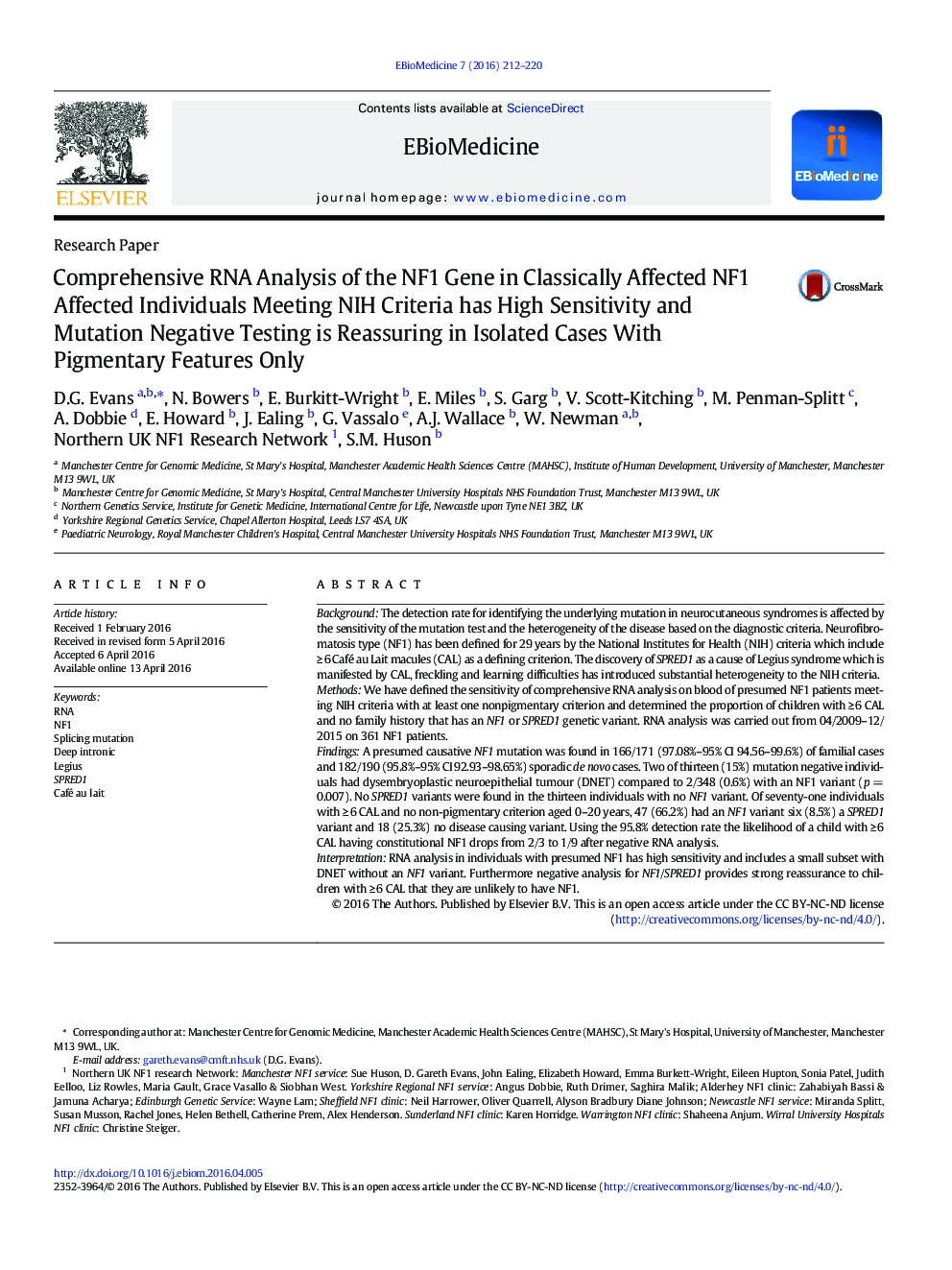| کد مقاله | کد نشریه | سال انتشار | مقاله انگلیسی | نسخه تمام متن |
|---|---|---|---|---|
| 2120844 | 1546892 | 2016 | 9 صفحه PDF | دانلود رایگان |

• RNA testing for NF1 mutations has very high sensitivity (c.96%) and is significantly more sensitive than DNA testing.
• Mosaicism is not a major feature in those with classical NF1.
• Around two thirds of children with just 6 or more café au lait spots have NF1, 8% Legius syndrome.
• Patients with normal RNA testing who meet NF1 criteria but also have a DNET may have a fault in a yet to be identified gene.Identifying the underlying genetic mutation is of benefit to patients and their families as it clarifies the diagnosis, can give information on the likely disease course and allow predictive testing in pregnancy and early childhood. The present study has shown that testing of blood RNA has very high sensitivity (96%) and allows substantial reassurance to parents whose children have multiple Café au lait birthmarks that they are unlikely to have the poorer outcomes of NF1 if they test negative. Furthermore the study suggests that a different mechanism may underlie the association of NF1 features and a rare benign brain tumour called DNET.
BackgroundThe detection rate for identifying the underlying mutation in neurocutaneous syndromes is affected by the sensitivity of the mutation test and the heterogeneity of the disease based on the diagnostic criteria. Neurofibromatosis type (NF1) has been defined for 29 years by the National Institutes for Health (NIH) criteria which include ≥ 6 Café au Lait macules (CAL) as a defining criterion. The discovery of SPRED1 as a cause of Legius syndrome which is manifested by CAL, freckling and learning difficulties has introduced substantial heterogeneity to the NIH criteria.MethodsWe have defined the sensitivity of comprehensive RNA analysis on blood of presumed NF1 patients meeting NIH criteria with at least one nonpigmentary criterion and determined the proportion of children with ≥ 6 CAL and no family history that has an NF1 or SPRED1 genetic variant. RNA analysis was carried out from 04/2009–12/2015 on 361 NF1 patients.FindingsA presumed causative NF1 mutation was found in 166/171 (97.08%–95% CI 94.56–99.6%) of familial cases and 182/190 (95.8%–95% CI 92.93–98.65%) sporadic de novo cases. Two of thirteen (15%) mutation negative individuals had dysembryoplastic neuroepithelial tumour (DNET) compared to 2/348 (0.6%) with an NF1 variant (p = 0.007). No SPRED1 variants were found in the thirteen individuals with no NF1 variant. Of seventy-one individuals with ≥ 6 CAL and no non-pigmentary criterion aged 0–20 years, 47 (66.2%) had an NF1 variant six (8.5%) a SPRED1 variant and 18 (25.3%) no disease causing variant. Using the 95.8% detection rate the likelihood of a child with ≥ 6 CAL having constitutional NF1 drops from 2/3 to 1/9 after negative RNA analysis.InterpretationRNA analysis in individuals with presumed NF1 has high sensitivity and includes a small subset with DNET without an NF1 variant. Furthermore negative analysis for NF1/SPRED1 provides strong reassurance to children with ≥ 6 CAL that they are unlikely to have NF1.
Journal: EBioMedicine - Volume 7, May 2016, Pages 212–220